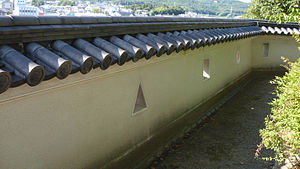Miki Castle
| Miki Castle 三木城 | |
|---|---|
| Miki, Hyogo | |
 A reconstructed wall of the former castle | |
| Type | Sengoku period castle |
| Site information | |
| Controlled by | Bessho Nagaharu |
| Condition | Partially reconstructed |
| Site history | |
| Built | 1492 |
| Built by | Bessho Nagaharu |
| In use | 1492-1615 |
| Materials | Stone |
| Demolished | 1615-1619 |
| Battles/wars | Siege of Miki |
Miki Castle (三木城,, Miki-jō) was a Japanese castle in Miki, Hyōgo, Japan. It was built by Bessho Nagaharu in the Sengoku period. Today some ruins and a partial reconstruction remain at the castle site.
Overview[]
Miki Castle was built by Bessho Nagaharu in around 1492. At that time, the Bessho family were powerful lords in Harima Province, now part of southwestern Hyogo. In 1615, after the Siege of Miki, the castle was dismantled as per the "One Castle Per Province" (一国一城,, Ikkoku-ichijō) order established by the Tokugawa Shogunate.[1]
A hill castle with three keeps, Miki-jō was built near the Minogawa river and Yunoyama and Miki highways, major transportation routes during the Sengoku period. Because of the flow of traffic and commerce made possible by the river and roads, Miki city was considered as an important transportation hub and center of industry at that time. [2]
Miki-jō was built to be almost entirely surrounded by natural barriers such as mountains, valleys and cliffs, so only a portion to the southeast of the castle was exposed.[1]
The site of the main keep of Miki-jō was converted into Uenomaru Park in 1897 during the Meiji period. In the park, there is a city museum and library.[1]
The siege of Miki[]
Miki Castle was the scene of a siege from spring 1578 to January 1580,[3] in which Toyotomi Hideyoshi laid siege to the castle, cutting off food supplies to Bessho Nagaharu,[4] a retainer of the Mōri clan.[5] Toyotomi ultimately gained control of the castle, but Bessho committed suicide, aged 27,[3] and Araki Murashige, Lord of Itami, escaped to rejoin the Mōri clan.[6]
Recent Activity[]
Since Taiga drama “Gunshi Kanbe” aired in 2014, visits to the Miki castle ruins and surrounding area have increased. The drama follows Kuroda Kanbe, a Sengoku period general, and shows the story of his life in Himeji and Miki cities. The people and local government of Miki city capitalized on the popularity of the drama by advertising the castle ruins and selling souvenir goods with symbols of the Sengoku period, to draw people to the city's historic sites. [7] That year, Miki city volunteers began offering tours of the sites of the Siege of Miki, which included the castle ruins, reconstructed outer-wall, and period buildings around the castle site. [8]
During the battle of Miki, Toyotomi Hideyoshi built earthwork fortifications around Miki-jō, which remain to this day, and were designated an important historic site by the Japanese government in 2013. [9]
Access[]
By train[]
- From Kobe
From Shin-Kobe Station or Sannomiya Station, take the Seishin-Yamate Line subway to Minatogawa-Kōen Station, change to the Shintetsu Arima Line for Suzurandai Station, at Suzurandai take the Shintetsu Ao Line to Miki Uenomaru Station - from there it's a five minute walk to the Miki Castle ruins. [10]
Shin-Kobe Station is accessible on the shinkansen from Tokyo, and Sannomiya Station is accessible on the from Osaka Station.
By bus[]
- From Kobe
The Miki Castle ruins are accessible by Kamihime Nishiwaki Express bus from Sannomiya bus terminal at Sannomiya Station. The Uenomaru bus stop is a ten-minute walk from the castle ruins.
By car[]
- From Miki
From the Miki-Ono IC tollgate of the San'yō Expressway, the Miki Castle ruins are accessible from National Highway 175 and Hyōgo Prefectural Road 20. Uenomaru Park, the site of the main keep of Miki Castle, has a free parking area.
Related pages[]
- Miki, Hyogo
References[]
- ^ Jump up to: a b c 宮田, 逸民 (2010). 三木城跡・付城跡群・多重土塁の縄張りと現状 [Miki Castle territory: castle ruins, the territory, and present condition of multiple earthen mounds.]. Japan: Yokoyama Press. p. 80-85.
- ^ Murata, Shuzo (2003). 日本の中世城館調査報告書修正 [Revised Report on Japanese Castles and Ruins of the Middle Ages]. Japan: Tōyō Shorin Press. p. 117-119.
- ^ Jump up to: a b "Miki City Cultural hall" (in Japanese). Japan: Miki City Cultural Hall. Retrieved 13 December 2014.
- ^ Turnbull, Stephen (2000). The Samurai Sourcebook. London: Cassell & C0. p. 230. ISBN 1854095234.
- ^ 三木城跡 [Miki castle ruins] (in Japanese). Japan: City of Miki. 3 July 2014. Archived from the original on 12 November 2007. Retrieved 13 December 2014.
- ^ Turnbull, Stephen (20 December 2011). Japanese Castles 1540-1640. Osprey Publishing. p. 48. ISBN 9781780962160.
- ^ "「官兵衛」にちなみ土産品2品 兵庫・三木市の助成で2業者が開発" [Two Companies Create Souvenires Related to Kanbei.]. Archived from the original on 15 March 2014. Retrieved 8 April 2019.
- ^ "市民ボランティアが三木合戦無料ガイド 29日から来月25日まで 兵庫" [Miki City Volunteer Group Begins Free Miki Siege Battle Tour]. Archived from the original on 16 December 2014. Retrieved 8 April 2019.
- ^ "「三木城跡」など国史跡指定 記念シンポで基調講演" [Ruins of Miki Castle and other historical buildings selected as "Kokushi Ato"]. Archived from the original on 17 May 2014. Retrieved 8 April 2019.
- ^ "三木城跡" [Miki Castle Ruins]. Archived from the original on 15 March 2018. Retrieved 8 April 2019.
External links[]
| Wikimedia Commons has media related to Miki Castle. |
Coordinates: 34°48′00″N 134°59′17″E / 34.7999°N 134.9880°E
- Castles in Hyōgo Prefecture
- Historic Sites of Japan
- Former castles in Japan
- Ruined castles in Japan

